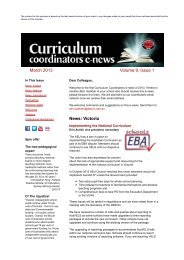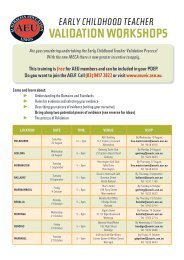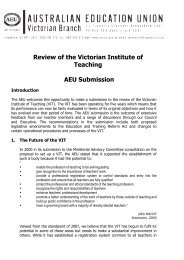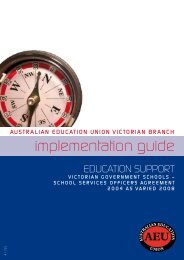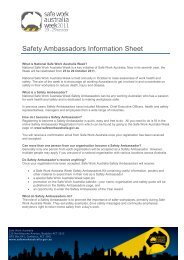Removing asbestos in workplaces - Compliance ... - WorkSafe Victoria
Removing asbestos in workplaces - Compliance ... - WorkSafe Victoria
Removing asbestos in workplaces - Compliance ... - WorkSafe Victoria
Create successful ePaper yourself
Turn your PDF publications into a flip-book with our unique Google optimized e-Paper software.
AppendicesThe follow<strong>in</strong>g are examples of situations <strong>in</strong> which atmospheric monitor<strong>in</strong>g may beneeded because of uncerta<strong>in</strong>ty about the level of exposure or whether there is a risk:• it is not clear whether new or exist<strong>in</strong>g risk controls are effective• the risk to health is largely controlled through the use of respiratory protection,but there are concerns that respiratory equipment has not been correctly selected,used, fitted, ma<strong>in</strong>ta<strong>in</strong>ed or stored, and employees have not been adequatelytra<strong>in</strong>ed <strong>in</strong> its use• the risk to health is largely managed through adm<strong>in</strong>istrative controls (ie safe workpractices or systems of work) and employees do not always follow these practices– perhaps due to lack of tra<strong>in</strong><strong>in</strong>g or supervision• there is evidence (such as dust deposits <strong>in</strong> the work area) that the risk controls(such as eng<strong>in</strong>eer<strong>in</strong>g controls) have deteriorated as a result of poor ma<strong>in</strong>tenance,or• process modifications or changes <strong>in</strong> work practices have occurred that mayadversely affect employee exposure.Where it is not practicable to elim<strong>in</strong>ate exposure to <strong>asbestos</strong>, the Regulations requirethat exposure to <strong>asbestos</strong> is reduced so far as is reasonably practicable for all peopleat the workplace.If it is obvious that there is potential for exposure to <strong>asbestos</strong>, priority needs to begiven to controll<strong>in</strong>g the risk rather than carry<strong>in</strong>g out atmospheric monitor<strong>in</strong>g just toconfirm that the potential for exposure exists. However, once controls have beenput <strong>in</strong> place, their effectiveness can be determ<strong>in</strong>ed by perform<strong>in</strong>g atmosphericmonitor<strong>in</strong>g.For further <strong>in</strong>formation about atmospheric monitor<strong>in</strong>g, refer to relevant documentedstandards, technical journals or publications issued by <strong>WorkSafe</strong> and the AustralianSafety and Compensation Council (ASCC). Further <strong>in</strong>formation and advice can beobta<strong>in</strong>ed from professionals such as occupational hygienists. Other employers <strong>in</strong>the <strong>in</strong>dustry could also be approached for advice.Who can conduct the atmospheric monitor<strong>in</strong>g?People who perform atmospheric monitor<strong>in</strong>g do not have to be approved under theRegulations. However, atmospheric monitor<strong>in</strong>g and the <strong>in</strong>terpretation of the results(<strong>in</strong>clud<strong>in</strong>g comparison with the <strong>asbestos</strong> exposure standard) need to be undertakenby a competent person, such as an occupational hygienist or safety professional,who has the appropriate qualifications, knowledge, skills and experience.The Australian Institute of Occupational Hygienists (AIOH) is an <strong>in</strong>corporated<strong>in</strong>stitute that represents the occupational hygiene field, both nationally and<strong>in</strong>ternationally. A list of service providers who may be able to conduct atmosphericmonitor<strong>in</strong>g can be found at aioh.org.au.Who can analyse the atmospheric monitor<strong>in</strong>g samples?If an analysis of any sample is required under the Regulations, the analysis mustbe undertaken by an approved analyst. The accurate identification of <strong>asbestos</strong> andcount<strong>in</strong>g of fibres by approved analysts is an important step <strong>in</strong> controll<strong>in</strong>g exposureto this harmful substance. The Regulations def<strong>in</strong>e an approved analyst as be<strong>in</strong>g:‘An analyst approved by the National Association of Test<strong>in</strong>g Authorities (NATA) toperform <strong>asbestos</strong> fibre count<strong>in</strong>g or to identify <strong>asbestos</strong> <strong>in</strong> samples, and to issuef<strong>in</strong>d<strong>in</strong>gs as endorsed reports under the authority of a NATA accredited laboratory.’96 <strong>Compliance</strong> code / <strong>Remov<strong>in</strong>g</strong> <strong>asbestos</strong> <strong>in</strong> <strong>workplaces</strong> <strong>WorkSafe</strong> <strong>Victoria</strong>




